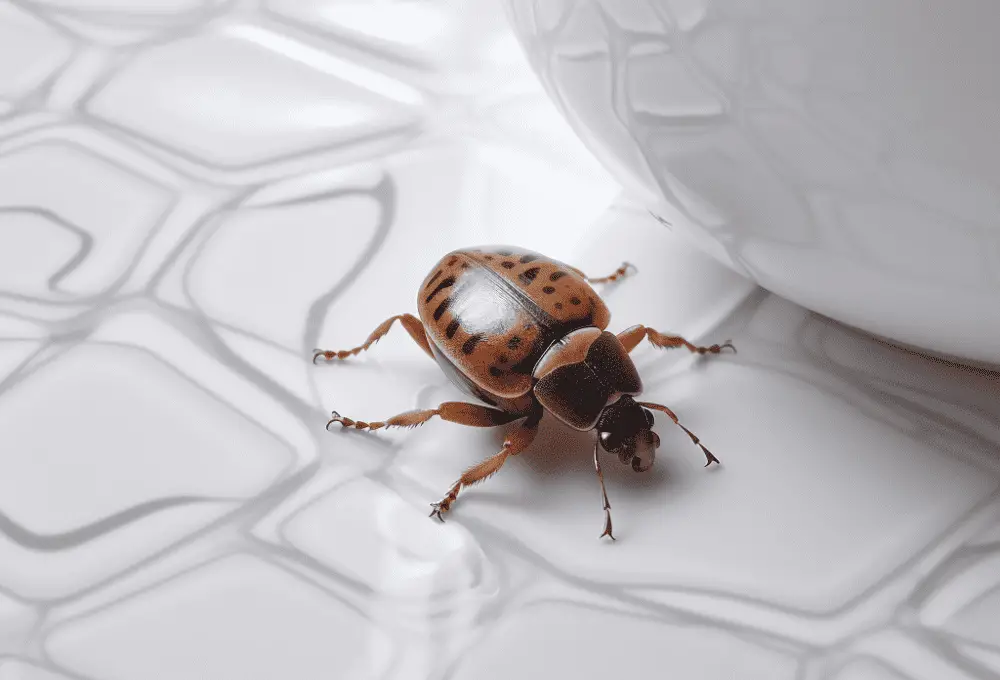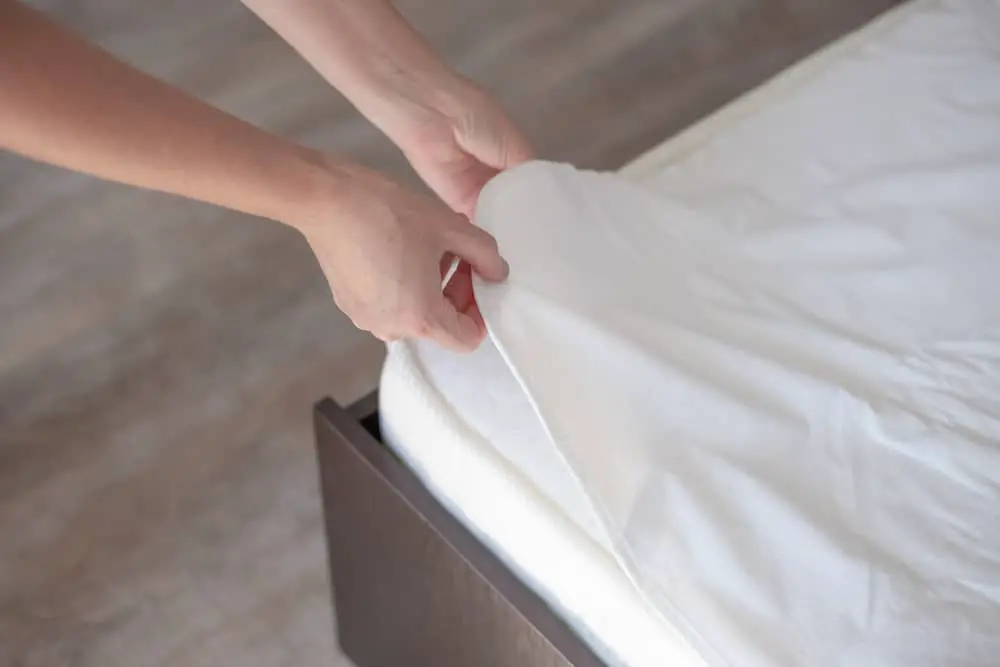Bed bugs are a common problem that many people face in their homes, causing sleepless nights and lots of discomfort. One proposed solution to prevent these pesky insects from making a home in your mattress is the use of plastic mattress covers.
Plastic mattress covers, also known as encasements or protectors, are designed to completely enclose a mattress, keeping it safe from a variety of potential threats.
Bed bugs have a difficult time navigating the smooth surface of the plastic, making it harder for them to find hiding spots or enter your mattress. Additionally, these covers can make it easier to spot bed bugs or their eggs, as the insects will be more visible against the bright, uniform surface of the cover.
While using plastic mattress covers can act as a barrier to bed bugs and reduce the likelihood of an infestation, it is important to note that a mattress cover alone may not guarantee absolute protection.
A combination of preventive measures, such as regular cleaning, monitoring, and early detection, should be employed, along with using a mattress cover to effectively keep bed bugs at bay.
Understanding Bed Bugs
Bed bugs are small, wingless insects that feed on human blood. They are nocturnal creatures and can be found in various environments, including homes, hotels, and public transportation.
Life Cycle and Feeding Habits
Bed bugs have a unique life cycle, going through several stages before reaching maturity. A female bed bug can lay hundreds of eggs throughout her lifetime, which are about the size of a speck of dust.
The eggs hatch after about 6 to 10 days, and the newly emerged nymphs begin searching for a blood meal to grow and develop. Bed bugs go through five nymphal stages before reaching adulthood, each requiring a blood meal to molt.
Bed bugs are attracted to their hosts by sensing body heat, carbon dioxide, and other chemical cues. Although they can survive up to a year without feeding, they typically feed every 5 to 10 days when hosts are available.
Bed bugs use their specially adapted mouthparts to puncture the skin and draw out blood, usually for about 3 to 10 minutes before retreating to their hiding places.
Infestations and Signs
An infestation often begins when bed bugs are transported from an infested area into previously uninfested locations via luggage, furniture, or clothing. They can also move between rooms or units in multi-dwelling buildings.
When it comes to identifying a bed bug infestation, physical evidence is crucial. Check for the following signs:
- Bite marks: Bed bugs usually feed on areas exposed during sleep, such as the face, neck, arms, and hands. Their bites can cause small, red, itchy welts, though not everyone experiences a reaction.
- Fecal spots: Bed bug excrement resembles small, dark spots, often found on bed sheets, mattress seams, and other hiding places.
- Shed skins: As bed bugs progress through their nymph stages, they leave behind tiny, translucent, molted skins.
- Live bugs: Adult bed bugs are reddish-brown, flat, and roughly the size of an apple seed. They are often found hiding in cracks, crevices, and mattress seams.
Role of Mattresses in Bed Bug Infestation
How Bed Bugs Infest Mattresses
Bed bugs are notorious for their ability to infest various household items, and mattresses are no exception. These pesky insects can quickly turn a comfortable night’s sleep into a nightmare by infesting your mattress, box spring, pillows, and bed sheets.
Bed bugs are attracted to the warmth and carbon dioxide emitted by humans, making your bed an ideal target for them to find their next meal.
Initially, bed bugs may enter your home through various means, such as luggage, clothing, or used furniture items. Once inside, they seek out cozy hiding spots, such as your mattress and its associated linens, to multiply and establish their colonies.
Common Hiding Places
In order to understand how to prevent bed bugs from infesting your mattress, it’s essential to know their favorite hiding places.
Some of the most common areas where bed bugs tend to hide within and around your bed include:
- Mattress seams: Bed bugs often burrow into the seams of your mattress, seeking shelter from light and disturbance.
- Box spring: The box spring provides a large, hidden area for bed bugs to hide and multiply, making it a common hiding spot.
- Pillows: Similar to mattresses, bed bugs can also infest your pillows by hiding within seams and fabric folds.
- Bed sheets: Bed bugs can easily hide amongst the folds of your bed sheets, particularly near the mattress seams.
- Headboards: The space between the wall and your headboard, as well as the headboard’s various nooks and crannies, can provide a safe haven for bed bugs.
To prevent bed bug infestations in your mattress and other bedding items, adopting a combination of preventative measures and regular cleaning practices is key.
Plastic mattress covers are just one helpful tool to help keep these pests at bay.
Plastic Mattress Covers and Prevention
How Plastic Mattress Covers Work
Plastic mattress covers, also known as encasements or mattress protectors, are designed to protect your mattress from bed bugs.
These products create a physical barrier around your mattress with a tight-fitting, waterproof material like vinyl or polyester. The cover seals off the mattress, trapping any existing bed bugs inside and preventing new ones from entering. By doing this, you can protect yourself from bed bug infestations and keep your bedding clean and hypoallergenic.
Types of Mattress Encasements and Materials
There are several types of mattress encasements available in the market, offering different levels of protection and comfort:
- Vinyl encasements: These are typically the most affordable option and provide a complete barrier against bed bugs. However, vinyl is not very breathable, which can cause discomfort and increased perspiration during sleep.
- Polyester encasements: Made from a lightweight, hypoallergenic material, polyester mattress covers offer a more breathable solution than vinyl. They provide adequate protection against bed bugs while also allowing for better air circulation.
- Layla Full Encasement Mattress Protector: This product features a six-sided design to protect every part of your mattress from bed bugs. Made from a blend of polyester and other materials, it offers great breathability and comfort.
- Linens & Hutch 6-Sided Mattress Encasement: Another six-sided mattress protector, this one also provides protection against bed bugs with its hypoallergenic material. It’s machine-washable, making maintenance easy and convenient.
To choose the right mattress encasement for your needs, consider factors like your budget, personal comfort preferences, and the level of protection you require. When shopping for a mattress protector, look for products made from high-quality, hypoallergenic materials and with tight-fitting zippers to keep bed bugs out.
Remember that even the best mattress cover can’t prevent bed bugs entirely if other preventative measures aren’t taken, so diligent cleaning and inspection routines are essential to keep your sleeping environment bug-free.
Bed Bug Prevention Strategies
Protecting Your Belongings
To prevent bed bugs, it’s essential to create a barrier between the bugs and your belongings. One way to do this is by using plastic mattress covers, which help protect your mattress from becoming a breeding ground. These covers are designed with zippers that effectively block bed bugs from entering or escaping.
Another effective method is sealing any small openings in electrical outlets and wallpaper to prevent bed bugs from hiding in these spaces. Additionally, keep suitcases and clothes stored in sealable bags or containers to keep bed bugs from infesting them.
Cleaning and Maintenance
Cleaning and maintenance are crucial for bed bug prevention. Regularly vacuum your home, paying close attention to areas where bed bugs may hide, such as curtains, mattresses, and furniture.
Vacuuming helps remove any potential food sources, like dead skin cells, that may attract bed bugs. After vacuuming, empty the vacuum cleaner bag outside, and clean the vacuum with a cloth to eliminate any remaining bugs.
Another essential aspect of bed bug prevention is washing your clothes and bedding frequently and at the highest recommended temperature. This helps to kill any bed bugs that may be hiding in your linens. Dispose of any infested items in a sealed plastic bag.
Lastly, avoid using pesticides indiscriminately, as they may not be effective against all bed bug life stages. Instead, opt for a pest control professional if you suspect an infestation in your home. Regularly inspect your living space for any signs of bed bugs and take action immediately if you notice any evidence of their presence.
Identifying and Treating Bed Bug Infestations

Bed bug infestations are a common issue in many households. These tiny insects can cause significant discomfort, especially with their bites causing itching and allergens.
Also, they can lead to the presence of dust mites, mildew, and even diseases. In this section, we will discuss how to recognize bed bug bites and when to seek professional help for treating infestations.
Recognizing Bed Bug Bites
Bed bug bites can be challenging to identify as they may resemble bites from other insects or rashes. However, they generally have some key features:
- Color: Bed bug bites are typically red and may have a darker central spot.
- Pattern: Bites appear in clusters or lines, which can be a key clue to their source.
- Itching: Intense itching is common around the bites, which can lead to further skin irritation.
If you notice these signs, it’s essential to inspect your surroundings, particularly your mattress and bedding. The presence of actual bed bugs, their eggs, or fecal spotting will confirm an infestation.
When to Seek Professional Help
While minor infestations can sometimes be managed through regular cleaning and the use of mattress covers, there are instances when professional pest control is necessary:
- If the infestation persists despite your efforts, it may be time to consult a professional.
- In complex living situations like shared spaces or apartments, pest control may be required to treat the entire area.
- If you have a memory foam mattress, treatment is more challenging and may need professional knowledge.
As a renter, you may be entitled to compensation if your landlord fails to address a bed bug infestation. Keeping documentation and informing your landlord about the issue in a timely manner is crucial for seeking potential remedies.
By understanding the signs of bed bug infestations and knowing when to seek professional help, you can prevent these pests from taking over your home and causing physical and emotional distress.
Additional Considerations and Tips
Can Plastic Mattress Covers Help with Other Issues
Plastic mattress covers can provide benefits beyond bed bug prevention. One notable advantage is their waterproof feature. This helps protect the mattress from liquids, reducing the likelihood of mold growth. In addition, they provide a barrier against other common household pests, offering extra protection for your bed.
It is essential, however, to ensure that the mattress cover has a secure zip to prevent any bugs or liquids from entering or escaping. Remember, a high-quality cover is a worthwhile investment for overall cleanliness and hygiene.
Customer Reviews and Feedback
When searching for a plastic mattress cover, it’s always a good idea to check customer reviews and feedback. Pay close attention to comments about the cover’s effectiveness against bed bugs, its durability, and ease of installation.
- Effectiveness: Make sure that customers report that the cover has successfully prevented bed bug infestations, as this is the primary function. Look for comments mentioning the tightness of the zippers and the ability to block body heat and prevent bed bugs from feeding.
- Durability: A good cover should be long-lasting and resistant to tears or punctures. Check if customers mention the cover’s thickness and overall quality.
- Ease of Installation: To ensure you get the most protection from the cover, it should be easy to place onto your mattress without too much hassle.
Taking the time to consider these additional factors will help you make an informed decision and ultimately find the most effective plastic mattress cover for your needs.








